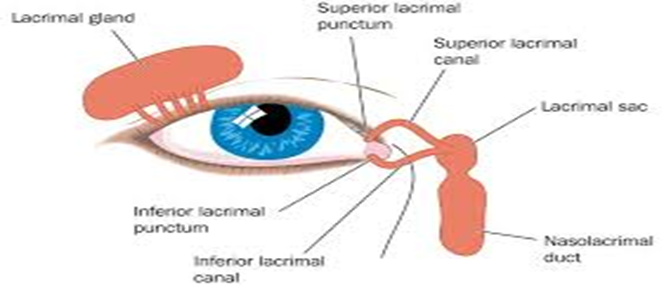A middle-aged school teacher complains of excessive tearing of the eyes every morning. Which assessment should the nurse perform next?
Assess the nasolacrimal sac
Inspect the palpebral conjunctiva
Test pupillary reaction to light
Perform the eye positions test
The Correct Answer is A
Choice A Reason:
The nasolacrimal sac is part of the tear drainage system. When a patient presents with excessive tearing, known as epiphora, it is important to assess for any obstruction in the lacrimal apparatus. The nasolacrimal sac can become blocked due to various reasons such as infection, inflammation, or structural abnormalities. Assessing this area can help determine if there is a blockage causing the tears to accumulate and overflow.
Choice B Reason:
Inspecting the palpebral conjunctiva is typically done if there is a complaint of eye pain or a sensation of a foreign body in the eye. While it is part of a comprehensive eye examination, it is not the first assessment to be performed for excessive tearing unless there are additional symptoms that suggest a problem with the conjunctiva.
Choice C Reason:
Testing the pupillary reaction to light is an assessment of the pupillary response and the function of the oculomotor nerve. This test is crucial when neurological issues are suspected or if there is a change in vision. However, it is not the primary assessment for excessive tearing without other associated symptoms.
Choice D Reason:
The eye positions test, which assesses eye muscle strength and cranial nerve function, is not necessary unless there are signs of problems with muscle strength, such as drooping. This test would not typically be the next step in assessing a patient with excessive tearing unless there are other indications of muscle or nerve impairment.

Nursing Test Bank
Naxlex Comprehensive Predictor Exams
Related Questions
Correct Answer is C
Explanation
Choice A Reason:
While falls are a common cause of injury in children, they are not the leading cause of TBI in adolescents. Falls tend to be more frequent in the younger population, particularly in children under the age of 4. In adolescents, sports-related injuries and motor vehicle accidents are more prevalent causes of TBI.
Choice B Reason:
The statement that females have twice the risk of TBI compared to males is incorrect. National data reveal that males are at increased risk of TBI compared to females, especially in the adolescent age group. This is likely due to higher engagement in risk-taking behaviors and contact sports.
Choice C Reason:
Concussions in sports and motor vehicle accidents are indeed the leading causes of TBI in adolescents. Engaging in contact sports such as football, hockey, and soccer can lead to concussions, which are a form of mild TBI. Motor vehicle accidents are also a significant risk factor due to high-impact collisions that can cause head injuries.
Choice D Reason:
Firearm incidents are a serious concern for TBI; however, they are not the most common cause of TBI in adolescents. While firearm-related injuries can be severe and are a leading cause of TBI-related deaths, concussions from sports and motor vehicle accidents account for a larger number of non-fatal TBIs in this age group.
Correct Answer is ["A","B","C","D"]
Explanation
Choice a reason:
Wearing nonslip shoes in the house is a preventive measure against falls, which are a leading cause of traumatic brain injuries (TBIs) in adolescents. Nonslip shoes provide better grip and stability, especially on potentially slippery surfaces like tiles or polished wood, reducing the risk of slips and falls that can lead to head injuries.
Choice b reason:
The supervised use of guns by an adult is critical in preventing accidental shootings, which can result in TBIs. Adolescents may lack the maturity and experience to handle firearms safely, and adult supervision ensures that proper safety protocols are followed, reducing the risk of accidental discharge and potential injury.
Choice c reason:
The use of seat belts is one of the most effective ways to prevent TBIs in the event of a vehicle accident. Seat belts restrain the body and prevent individuals from being thrown around inside or ejected from the vehicle, significantly reducing the likelihood of head trauma.
Choice d reason:
Avoiding risky activities such as snowboarding without proper safety equipment is essential in preventing sports-related TBIs. Snowboarding, like other high-speed sports, carries a risk of falls and collisions, which can cause head injuries. Wearing helmets and other protective gear, and engaging in these activities with caution, can mitigate this risk.
Whether you are a student looking to ace your exams or a practicing nurse seeking to enhance your expertise , our nursing education contents will empower you with the confidence and competence to make a difference in the lives of patients and become a respected leader in the healthcare field.
Visit Naxlex, invest in your future and unlock endless possibilities with our unparalleled nursing education contents today
Report Wrong Answer on the Current Question
Do you disagree with the answer? If yes, what is your expected answer? Explain.
Kindly be descriptive with the issue you are facing.
